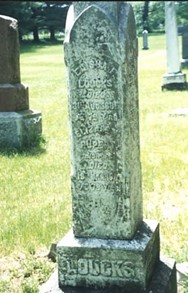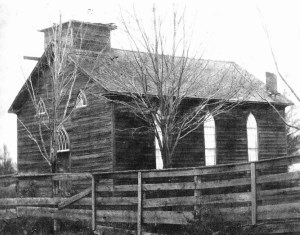Loucks Cemetery

This plaque commemorating the Loucks Cemetery was added to the Historical Plaque Program in 2022, in partnership with the Russell and District Historical Society. The Loucks Cemetery is just south of the Castor River, on Lot 10, Concession 4.
A deed dated in 1860 shows John William Loux selling a parcel of land to the trustees of the congregation of the Presbyterian Church of Canada in the Village of Luxemburg, to erect a church, a manse and for a burying ground. He sold the parcel for 5 shillings. The lot measured 35 metres by 116 metres.
The first trustees of the congregation were Messrs. E.F. Loucks, William Eadie, Alexander McGregor, Andrew Meharey and Robert McLaren.
Loucks Cemetery was officially established in 1860, when a church was built on the land. However, the land was used as a cemetery long before this. The earliest known burial is Charles Duncan in 1847, son of William Duncan, the community’s first postmaster.
The oldest person buried is Elia Jane Morrow, wife of John Stevenson. Elia was born in County Cavan, Ireland in 1833 and died in 1933 at 100 years of age.
This cemetery contains the graves of two of the Township’s first settlers, Elisha and Elizabeth Loucks.
The Loucks Family

The family of Elisha Fox Loucks (formerly spelled Loux) were French protestants (Huguenots) that were persecuted by the French Catholics in Europe. They came from Luxembourg in Europe, moved to the Mohawk Valley in New York State, USA, then to Osnabruck area of Upper Canada, and finally, to Russell along the old Forced Road.
In 1827, Elisha Fox Loucks was purchasing land and operating what would be the first grist mill in the Township. The water-powered mill was on the north side of the Castor River, just east of the Wade Road Bridge in an area that was known as Luxemburg. In 1829, Elisha Loucks built a log house at 1135 Eadie Road at the corner of Eadie Rd. and Castor Street. By 1835 Elisha Loucks, also had a sawmill.
Elisha’s House
Before building the first Presbyterian church building in 1858, services were held in the upstairs of Elisha Loucks’ house. This was known as the Free Presbyterian Church. The church was a frame building having three long windows on each side and two small windows in the front. All the wood came from the local sawmill. 
As the congregation grew and the Village of Luxemburg was overshadowed by the more enterprising Village of Duncanville, there was need to build a larger building. By 1885, the congregation purchased land on Mill Street in Duncanville. A new church made of brick, called the St. Andrews Presbyterian church, opened in 1888.
The cemetery was known as the Presbyterian cemetery until 1925. The congregation of St. Andrew’s Presbyterian Church united with St. Paul’s Methodist Church to become the United Church of Canada. Today, the operation of the cemetery is under St. Andrew’s and St. Paul’s United Church.
Learn more about the historical significance of St. Andrew’s and St. Paul’s United Cemetery.
References
Boyd, Keith M.; Harold Gamble. 1987. Historical Sketch of Russell St. Andrew’s Presbyterian Congregation 1845-1925, St. Paul’s Methodist Congregation 1860-1925, St. Andrew’s and St. Paul’s United Church 1925-1987. 158 p.
Collins, Evalyn; Fern Small, Ken Collins. 1981. Loucks Cemetery, Russell County, Russell Township. Publication 82-4, Ottawa Branch of the Ontario Genealogical Society, 11 p.
Stanley, W.M. 1987. From Swamp and Shanty – the history of Russell Village and the western part of Russell Township 1827-1987. Runge Press Ltd, Ottawa, Ontario.
